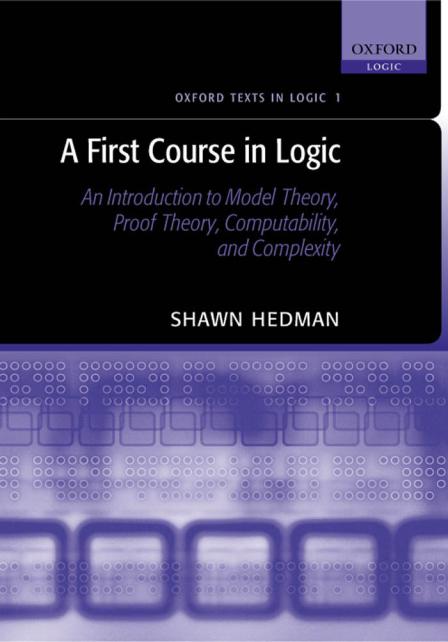
Hedman. A First Course in Logic, 2004 (Oxford)
.pdf
A First Course in Logic
This page intentionally left blank

A First Course in Logic
An introduction to model theory, proof theory, computability, and complexity
S H A W N H E D M A N
Department of Mathematics, Florida Southern College
1
3
Great Clarendon Street, Oxford OX2 6DP
Oxford University Press is a department of the University of Oxford.
It furthers the University’s objective of excellence in research, scholarship, and education by publishing worldwide in
Oxford New York
Auckland Cape Town Dar es Salaam Hong Kong Karachi
Kuala Lumpur Madrid Melbourne Mexico City Nairobi
New Delhi Shanghai Taipei Toronto
With o ces in
Argentina Austria Brazil Chile Czech Republic France Greece Guatemala Hungary Italy Japan Poland Portugal Singapore South Korea Switzerland Thailand Turkey Ukraine Vietnam
Oxford is a registered trade mark of Oxford University Press in the UK and in certain other countries
Published in the United States
by Oxford University Press Inc., New York
c Oxford University Press 2004
The moral rights of the author have been asserted
Database right Oxford University Press (maker)
First published 2004
Reprinted (with corrections) 2006
All rights reserved. No part of this publication may be reproduced, stored in a retrieval system, or transmitted, in any form or by any means, without the prior permission in writing of Oxford University Press,
or as expressly permitted by law, or under terms agreed with the appropriate reprographics rights organization. Enquiries concerning reproduction
outside the scope of the above should be sent to the Rights Department, Oxford University Press, at the address above
You must not circulate this book in any other binding or cover and you must impose the same condition on any acquirer
A catalogue record for this title is available from the British Library Library of Congress Cataloging in Publication Data
Data available
Typeset by Newgen Imaging Systems (P) Ltd., Chennai, India
Printed in Great Britain on acid-free paper by
Biddles Ltd., King’s Lynn, Norfolk
ISBN 0–19–852980–5 (Hbk)
ISBN 0–19–852981–3 (Pbk)
10 9 8 7 6 5 4 3 2
To Julia
This page intentionally left blank

Acknowledgments
Florida Southern College provided a most pleasant and hospitable setting for the writing of this book. Thanks to all of my friends and colleagues at the college. In particular, I thank colleague David Rose and student Biljana Cokovic for reading portions of the manuscript and o ering helpful feedback. I thank my colleague Mike Way for much needed technological assistance. This book began as lecture notes for a course I taught at the University of Maryland. I thank my students and colleagues in Maryland for their encouragement in beginning this project.
The manuscript was prepared using the MikTex Latex system with a GNU Emacs editor. For the few diagrams that were not produced using Latex, the Gimp was used (the GNU Image Manipulation Program). I would like to thank the producers of this software for making it freely available.
I cannot adequately acknowledge all those who have shaped the subject and my understanding of the subject contained within these pages. For the many names of logicians and mathematicians mentioned in the book, I fear there are many deserving names that I have left out. My apologies to those I have slighted in this respect. Many people, through books and personal interaction, have influenced my presentation of the subject. The books are included in the bibliography. Of my teachers, two merit special mention. I thank John Baldwin and David Marker at the University of Illinois at Chicago from whom I learned so much not so long ago. It is my hope that this book should lead readers to their outstanding books on Stability Theory and Model Theory.
Most importantly, I must acknowledge my wife Julia and our young children Max and Sabrina. From Sabrina’s perspective, this book has been a life-long project. To Julia and Max, it may have seemed like a lifetime. It is to Julia that I owe the greatest debt of gratitude. Without Julia’s enduring patience, e ort, and support, this book certainly would not exist.
This page intentionally left blank

Contents
1 Propositional logic |
1 |
||
1.1 |
What is propositional logic? |
1 |
|
1.2 |
Validity, satisfiability, and contradiction |
7 |
|
1.3 |
Consequence and equivalence |
9 |
|
1.4 |
Formal proofs |
12 |
|
1.5 |
Proof by induction |
22 |
|
|
1.5.1 |
Mathematical induction |
23 |
|
1.5.2 |
Induction on the complexity of formulas |
25 |
1.6 |
Normal forms |
27 |
|
1.7 |
Horn formulas |
32 |
|
1.8 |
Resolution |
37 |
|
|
1.8.1 |
Clauses |
37 |
|
1.8.2 |
Resolvents |
38 |
|
1.8.3 |
Completeness of resolution |
40 |
1.9 |
Completeness and compactness |
44 |
|
2 Structures and first-order logic |
53 |
||
2.1 |
The language of first-order logic |
53 |
|
2.2 |
The syntax of first-order logic |
54 |
|
2.3 |
Semantics and structures |
57 |
|
2.4 |
Examples of structures |
66 |
|
|
2.4.1 |
Graphs |
66 |
|
2.4.2 |
Relational databases |
69 |
|
2.4.3 |
Linear orders |
70 |
|
2.4.4 |
Number systems |
72 |
2.5 |
The size of a structure |
73 |
|
2.6 |
Relations between structures |
79 |
|
|
2.6.1 |
Embeddings |
80 |
|
2.6.2 |
Substructures |
83 |
|
2.6.3 |
Diagrams |
86 |
2.7 |
Theories and models |
89 |
|
